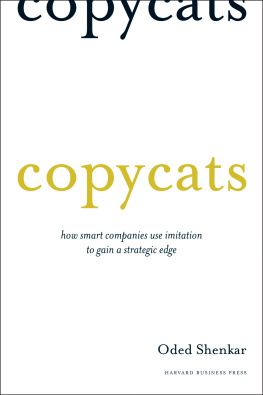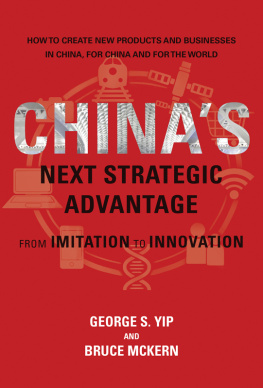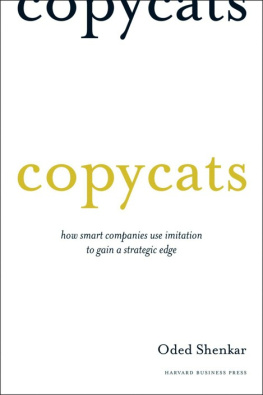Acknowledgments
The roots of this book go back a long way. Like all infants, I must have used imitation to learn how to communicate and master basic skills and, later in life, acquire social norms and mores. As an adult, I have learned the hard way that imitation is often well rewarded. Early in my scholarly career, a former classmate approached me in an academic conference to inquire about the research I was working on. Graciously, I disclosed the idea and provided a blueprint for its development and empirical investigation, including the source of data. It did not take long before I saw his copy in print, eventually forming the basis for his academic career in a center in a well-known urban university. As an older and hopefully wiser scholar, I shared an interest in innovation, imitations more respected sibling, which seemed to permeate virtually all significant concepts in business. It was when I combined this interest with a lifelong fascination with China, a country that was fast becoming an imitation Mecca, that I realized the importance of imitation but also its sensitivity. Indeed, I knew I was on to something when the Chinese edition of my book The Chinese Century omitted the entire chapter on intellectual property rights (IPR) infringement.
Imitation also was omnipresent in my life as a practitioner. Working with firms large and small, I have dealt with issues that, in hindsight, were all somehow connected to imitation and its supposed oxymoron, innovation, although at the time I did not connect the dots. The startups I worked with have tried to convince the venture capitalists and strategic partners I approached on their behalf that they were doing something novel, but in arguing the feasibility of the concept have often hinted that they were imitating a working model. The larger corporations I advised were keen on finding out what made their competitors tick but were loath to admit that they were imitating anyone even when it was clear that they were, or had to. We are an innovating company, I was constantly reminded by executives, who were expressing bewilderment and dismay at the very suggestion that they were imitating and who repeatedly questioned the premise that imitation was a reasonable, not to say a rational and profitable, course. In this book, I try to convince you otherwise.
You may be surprised to find many references to inspiration in a book about imitation, but then this is part of the message. What I would like to acknowledge here is the inspiration I received from a number of people who have made this idea come to life. They include not only the scholars from far afield, such as biology and neuroscience, and the executives who took time from their busy schedules to talk about a sensitive topic, but also several individuals who have provided vital support for my contrarian venture. Christine Poon, dean of the Fisher School at Ohio State; Steve Mangum, senior associate dean; David Greenberger, chairman of the HRM department; and members of the development office have all been highly supportive of this venture. At Harvard Business Press, Jacque Murphy has helped get the book off the ground before placing it in the very capable hands of Kathleen Carr. Kathleen was my editor and has done a superb job at that, but she fulfilled a much bigger role, that of a scholar, a colleague, and, if I may say so, a friend, deploying her intelligence, experience, and infinite patience as a still maturing product evolved.
Last but not least, thanks to my wife Miriam, who provides inspiration and support for everything I do.
About the Author
Oded Shenkar holds degrees in East-Asian studies and sociology from the Hebrew University of Jerusalem, and a PhD from Columbia University, where his dissertation on the Chinese bureaucracy involved work in sociology, business, and East-Asian studies. He is the Ford Motor Company Chair in Global Business Management and Professor of Management and Human Resources at the Fisher College of Business, The Ohio State University. Professor Shenkar has also taught at the University of Cambridge, the University of Birmingham, Peking University, University of International Business and Economics (Beijing), IDC (Israel), and the International University of Japan, among many others.
He has published nearly one hundred articles in leading journals such as Academy of Management Review, Academy of Management Journal, Journal of Applied Psychology, Human Relations, Journal of International Business Studies , and Strategic Management Journal , among many others. His books include Organization and Management in China 19791990 (M.E. Sharpe), International Business in China (Routledge, with L. Kelley), Global Perspectives on Human Resource Management (Prentice-Hall), The Handbook of International Management Research (University of Michigan Press, with B. J. Punnett), International Business (Wiley; Sage [2nd ed.] with Yadong Luo), The Handbook of Strategic Alliances (Sage, with Jeff Reuer), and The Chinese Century (Wharton School Publishing), which has been translated into twelve languages.
His work has been cited by the Wall Street Journal , New York Times , Financial Times , Los Angeles Times , USA Today , Chicago Tribune , Boston Globe , Daily Mail (UK) , Liberation (France) , International Herald Tribune , Time , BusinessWeek , Economist , Chief Executive , Associated Press, Reuters, Nikkei Financial Daily , China Daily , Reference News (China) , and China Business Weekly , as well as on radio (e.g., NPR, CBS) and TV (e.g., Reuters, ABC, Canadian Business TV, Korean TV, Bloomberg).
Professor Shenkar has been an adviser to firms (e.g., Battelle, Diamond Power International, Netafim, Wal-Mart) in the United States, the United Kingdom, Japan, Korea, China, and Israel, governments (e.g., Department of Business and Economic Development, State of Hawaii), international institutions (e.g., International Labor Office), and universities (e.g., the Chinese University of Hong Kong). He appeared before the U.S.China Economic and Security Review Commission and the Western Governors Association, among others, and is a past vice president and fellow of the Academy of International Business.
Notes
Chapter 1
Hogan, D. G. 2007. Selling em by the sack: White Castle and the creation of American food. New York: NYU Press; Rivkin, J. W. 2001. Reproducing knowledge: Replication without imitation at moderate complexity. Organization Science 12, 3, 274293; Big bite. 2008. Economist , April 26, p. 107.
Adamy, J. 2007. Yum uses McDonalds as guide in bid to heat up sales. Wall Street Journal , December 13, A21.
Teece, D. 1986. Profiting from technological innovation: Implications for integration, collaboration, licensing and public policy. Research Policy 15, 285305.
S. P. Schnaars provides numerous case histories of late entrants winning against pioneers. See Schnaars, S. P. 1994. Managing imitation strategies: How late entrants seize markets from pioneers. New York: Free Press.
Connor, C. 2008. Interview with author, October 24.
See, for instance, Schnaars, Managing imitation strategies.
Mansfield, E., Schwartz, M., and Wagner, S. 1981. Imitation costs and patents: An empirical study. Economic Journal 91 (December), 907918; Levin, R., et al.1984. Survey research on R&D appropriability and technological opportunity. Working Paper Part 1: Appropriability. New Haven, CT: Yale University; Burns, G. 1995. A Fruit Loop by any other name... BusinessWeek , June 26, 7376, as cited in Collins-Dodd, C., and Zaichkowsky, J. L. 1999. National brand responses to brand imitation: Retailers versus other manufacturers. Journal of Product and Brand Management 8, 2, 96105; Belson, K. 2008. Hertz tosses some car keys into the ring, battling Zipcar. Wall Street Journal , December 17, B7.










